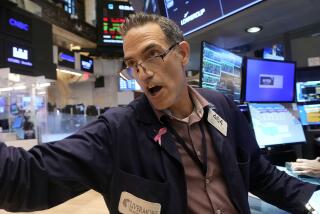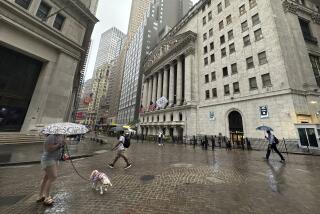Wall Street holds relatively steady ahead of big tests coming in the week

NEW YORK — U.S. stocks drifted through a quiet Monday to finish mixed as markets around the world stabilized after a wild week of extreme swings.
The Standard & Poor’s 500 index finished little changed, edging up by less than 0.01%, after flipping between small gains and losses through the day. The Dow Jones industrial average slipped 0.4%, and the Nasdaq composite rose 0.2%.
Many European and Asian stock markets were also relatively quiet. That’s a notable turn after last week kicked off with the worst day for Japanese stocks since the Black Monday crash of 1987, only to give way to the best day since 2022 for U.S. stocks.
The value of the Japanese yen eased Monday, calming some more after an earlier surge sent shock waves through markets. The sharp rise for the Japanese yen following a hike to interest rates by the Bank of Japan forced many hedge funds and other investors to abandon a popular practice all at once, in which they had borrowed yen at cheap rates to invest elsewhere. The forced selling reverberated around the world.
A promise last week by a top Bank of Japan official not to raise rates further as long as markets are “unstable” has helped calm the market. But other worries also were behind last week’s turbulence for markets, including concerns about a slowing U.S. economy.
This week will feature reports on inflation and how much U.S. shoppers are spending at retailers. The best-case scenario for Wall Street would be data showing a continued slowdown in inflation, combined with strengthening U.S. retail sales.
That would indicate the Federal Reserve is successfully walking the tightrope it’s been attempting since it began hiking interest rates sharply in 2022: It wants the U.S. economy to slow by enough to snuff out high inflation, but not so much that it causes a recession.
A string of worse-than-expected economic data recently has raised worries that the Fed may be leaning too far to one side on the tightrope after keeping its main interest rate at a two-decade high. The lowlight came this month when a report showed hiring by U.S. employers weakened by far more than expected.
For the inflation data, meanwhile, strategists at Bank of America led by Ohsung Kwon say a hotter-than-expected reading would be a bigger surprise for the market than a cooler-than-expected figure. That could lead to “a major downside event” for the market if inflation readings come in worse than forecast.
The Fed does not have an easy way to fix a weakening economy in which inflation is worsening, a phenomenon called “stagflation.” The central bank could ease rates, which would give the U.S. economy an upward push but threaten to worsen inflation. Or it could continue to keep its rate high. That would put downward pressure on inflation but inflict more pain on the economy.
Of course, the U.S. economy is still growing, and many economists see a recession as unlikely. But worries about it have nonetheless put downward pressure on Treasury yields in the bond market.
They fell again Monday ahead of the data reports. The yield on the 10-year Treasury slipped to 3.90% from 3.94% late Friday. The two-year Treasury yield, which more closely tracks expectations for Fed action, fell to 4.01% from 4.06%.
On Wall Street, the majority of stocks weakened. But a 4.1% jump for Nvidia helped offset many of those losses. Because it’s one of the largest U.S. stocks by value, Nvidia’s movements carry extra weight on the S&P 500 and other indexes.
It and other Big Tech behemoths have been shaky recently and mostly declining in the last month on worries that their stocks shot too high in the Wall Street’s frenzy around artificial intelligence technology.
KeyCorp jumped 9.1% after the regional bank announced a $2.8-billion investment from the Bank of Nova Scotia. The Cleveland bank said the cash influx will enable it to drive further growth in its investment banking and wealth management businesses.
On the losing end was Hawaiian Electric, which reported weaker results for the spring than analysts expected. The company also said it’s not sure it will be able to last at least another year as a “going concern” unless it can find financing to help pay the estimated $1.71 billion in liabilities it has built up related to the Maui windstorm and wildfire. Its stock sank 14.5%.
All told, the S&P 500 rose by less than a quarter of a point, 0.23, to 5,344.39. The Dow dropped 140.53 points to 39,357.01, and the Nasdaq composite gained 35.31 points to 16,780.61.
Several big companies will report their latest earnings results later in the week, including Walmart and Home Depot. Most big U.S. companies have been reporting better profits for the spring than analysts expected, but pressure is on retailers amid worries about how spenders at the lower end of the income spectrum are faring.
Choe writes for the Associated Press
More to Read
Inside the business of entertainment
The Wide Shot brings you news, analysis and insights on everything from streaming wars to production — and what it all means for the future.
You may occasionally receive promotional content from the Los Angeles Times.










